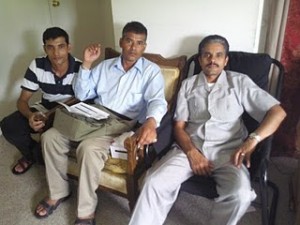Long journey from Burma to United States
Enough property, land and prestigious life of Kadel family in Burma (Myanmar) were always a source of jealous for his neighbors. Kewal R. Kadel’s mother was a self-learned spiritual jumping doctor (a woman who treats patient by praying and playing with the ghosts; believed in the conventional Nepali society). They earned a big cash and metallic wealth like gold, silver, brass, etc by treating sick people in their locality. This made kadel’s family miss the feeling of pains and sufferings while in Burma during 1940s.
But nobody can predict the future. History of Black days for Nepali ehnic people started in Myanmar, Burma. Suppression on Nepali ehnic Burmese during 1940s led a large number of Burmese leave their country. Kewal, his mother, elder brother and sister had to leave not only their land and property but their identity too.
And who knows all happiness is looted in no seconds. Sudden bomb blasts from the sky terrified the province people. Burma – Japan conflicts were on the horizon. Army fighters both in the sky and land were bombing and firing which marked a big question in the lives of thousands of Burmese people. All the bridges and entry-exit ways of the country were sealed. Kewal Ram and his family dug an ‘L’ shaped pit under the ground and stayed there for twelve months. But no signal of war conclusion was sensed.
They freed all their animals and fare welled all the home workers. They kept all their property under the ground. Tela Kadel, wife to Kewal Ram says, “Kewal Ram used to say; if I get chance to visit my birth place ever, I would take out all those properties”.
With no transportation, a five year old child Kewal desperately joined a very long, painful and tiresome journey to India with his family by foot. The earth and the grass, the green water on the lake, the trees near and far off hills, and the rocks and mountains were their friends along their journey. It was a long way walk of two months to reach India. Along with the Kadel family, a large number of Nepali ehnic Burmese moved to somewhere, where they were themselves unknown of their destination.
Everyone’s legs were heavy. “But…”, Kewal’s eldest son Devi Charan says, “…my father used to say that they felt a sense of being together in a group sharing each others’ sorrows”. They inhaled peace slowly putting themselves together along their way.
However, there were, for Kewal, no other options to escape or avoid the unbearable pains of sharp pebbles and thorns on their way.
After all pain and sufferings, Kadel and many other families who arrived India were in halfway house to decide their final destination. As days passed some choosed to go to Assam, some to Megalaya, some to Sikkim and Manipur and many other states of India. Among them, a large group entered Nepal. Still a group of Burmese refugees are found in Kakarvitta, Jhapa Nepal.
During their six months stay in India, Kewal’s elder brother left mother and sister with him and vanished in Assam, India. The then, he never met his brother. “But.”, his eldest son Devi Charan stressed, “…he felt his brother’s affection when he met his sister inlaw in Nepal.
Kewal’s family then decided to spend rest of their life in Bhutan, a tiny Himalayan country in South East Asia. Again the same pain repeated, it took almost one whole month for their foot to reach Bhutan. They were relieved when they reached Dagana district in Bhutan; a place which they called their HOME.
Monarch’s tyrannical rule again ended up Kadel’s stay in Bhutan after five decades of their entry into Bhutan. Democratic movement in 1990 AD demanding Human Rights and democratic systems in the country led one lakh Nepali ethnic southern Bhutanese (Lhotshampas) migrate to Southern Nepal as refugees. Kewal Ram with his four sons and five daughters had to leave their mother (died) and sister (married) in Bhutan itself.
Miracles of his life sometimes may be distrust for somebody. When Kewal Ram’s family entered Timai refugee camp in Nepal, the other Burmese refugees were in Kakarvitta, at a distance of some 20 kilometers. With the flow of time Kewal and many other who entered Nepal had a number of sons and grandsons. He became old and was suffered by asthma and was in bed for almost one and a half decade. It was in July 2004 that his physical existence left the earth. He struggled throughout his life to have HOME but couldn’t. This credit is now left on his son’s shoulders.
Kadel family lived for around two decades in exile as refugees in Nepal. Finally, through resettlement program Kewal’s eldest son Devi Charan with his family immigrated to Richmond, Virginia state of USA in June 2008 followed by his other brothers. Devi Charan says, “ this long journey of migrating country to country for safe and home, will definitely end now because USA is believed to be a safe country where every people has equal rights and nobody suppresses no one”. After a long breath he again added, “We have a dignified life here”.
Devi Charan’s words are some of many sorrowful stories of refugees around the world struggling for a safe place called HOME where they can stay permanently with no pressures.
After a moment of thought for the concluding lines Devi Charan concludes, “…let no generations pass a refugee life as we did”.
(Antim, who is a Bhutanese journalist in exile, blogs at antimnews from Virginia, USA)

